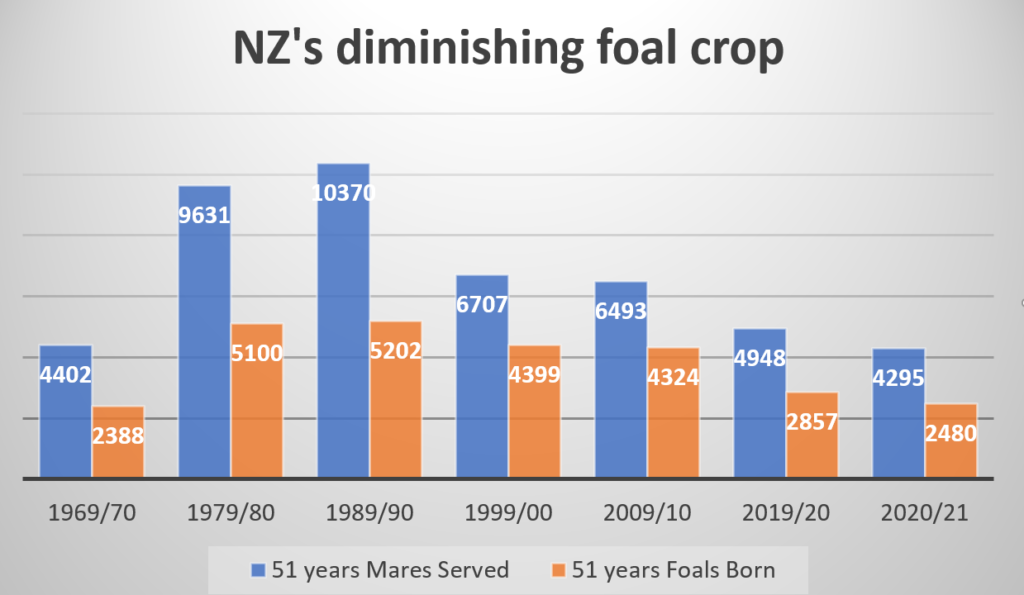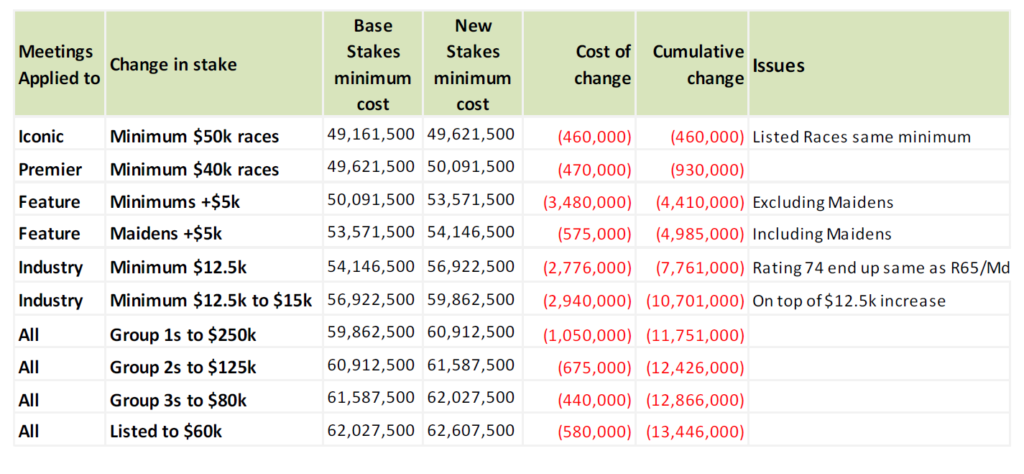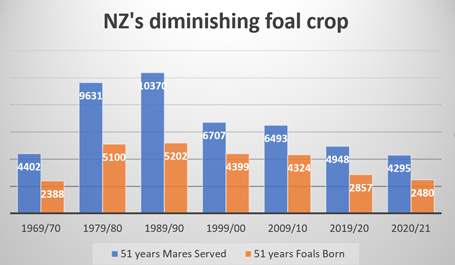by Brian de Lore
Published 18th June 2021
A reduction in the foal crop was the expectation of most pundits for 2021, but to learn the number of mares served in 2020 had reduced by 653 or 14 percent is another dagger in the side of a perennially weakening thoroughbred industry.
The figures supplied by NZTBA last week are saying the foal crop this coming spring will numerically be the smallest for 51 years since 2,388 foals were registered from foalings in 1970. In the history of thoroughbred breeding since Volume One of the NZ Stud Book was published in 1899, no single year has ever recorded a greater fall.
Using the ratio of mares covered to foals born from the 2019/20 season, the industry this coming spring can expect around 2,480 foals – almost half the number produced a dozen years ago. It’s a deplorable situation caused by inept administrations that have failed to recognise the need to drive the industry through increasing prizemoney – proof that breeders and owners are abandoning the industry.

The breeding business is the foundation of the whole damn industry. It’s driven by the owners who attend or don’t attend the yearling sales. Owners are incentivised by prizemoney – that’s how it works successfully in Australia, and that’s how it fails miserably in New Zealand.
The average at the Book One Karaka Yearling Sale of 2021 was down 12 percent on the previous year, with 100 fewer yearlings catalogued. COVID kept the Australians away, but the weakness of the domestic buying bench is now blatantly reflected and confirmed in the coming foal crop – the only other barometer in addition to pathetic prizemoney to determine the current state of the industry’s ill-health.
Tragically, it’s man-made. Avoidance was not only possible but feasible had commonsense prevailed. We didn’t need to waste $200 million on the FOB platform included with its 10-year financial commitments to Openbet and Paddy Power. We didn’t need to spend up to $66 million annually on salaries at the TAB, which has now been reduced but not nearly enough. We didn’t need to employ non-racing high flyers who made the movie Dumb and Dumber look clever. We didn’t need to ignore the most vital ingredient in the Messara Review, which said outsource/partner the TAB.
…the winds of change are blowing a mere zephyr where nothing less than a hurricane will suffice.
But we did all those things, and now we are paying. We didn’t need to stand idly by and allow it all to happen either (I remove myself from that flaccid group). Worst of all, not very much has changed – a little tweaking here and there – the winds of change are blowing a mere zephyr where nothing less than a hurricane will suffice.
The impact of an under 2,500 foal crop won’t be felt Today, this season, or even next. It will be three years down the track when we try and do our usual thing – catalogue 1,200 to 1,300 yearlings, export 1,750 odd thoroughbreds overseas, and supply enough horses for a domestic racing season. All three of those categories will be weakened, particularly domestic racing, which is likely to see fewer race meetings hosting smaller field sizes.
In the five seasons between 2014/15 and 2018/19, New Zealand exported 8,768 thoroughbreds at an average of 1,753/season. In the late 1990s and early 2000s we were averaging around 2,000 exports with the best season in 1998/99 when 2,175 left these shores. The decline started in 2003, coinciding with the Racing Act of 2003, and NZRB commenced its reign of mismanagement.
The figures for horses exported may be distorted by broodmares and racehorses crossing the Tasman for brief periods before returning. Nevertheless, the downward trend has continued at a similar rate of decline in line with thoroughbred production.
Erosian of demand from overseas inevitable
An annual lowering of the foal crop, diluting the quality, and erosion of the demand from overseas buyers are inevitabilities. However, Australian yearling and broodmare sales are booming along with further increases in recent times in both NSW and Queensland while we fall further behind.
Only this week, the Queensland State Government announced a $41 million package for racing to upgrade infrastructure. NSW followed with their equivalent package with a $67 million upgrade at rural racetracks.
NSW Deputy Premier John Barilaro, standing alongside Peter V’landys at Scone races this week, was quoted in the Sydney Telegraph as saying: “Thoroughbred racing is the lifeblood of many country towns, accounting for around 14,000 jobs in the regions and contributes $1.9 billion to the state’s economy.”
If only we had a Government here in New Zealand that recognised racing’s contribution to the GDP, its importance to the economy by way of employment, and then conclude that, like all industries the Government has meddled-in in the past, their control is the path to penury.
We are not even asking for more cash. The Government needs to take a leaf from the pages of the Jockey Club in England in 1978 when this authoritarian body did a volte-face on their tight grip of racing and relinquished control for the betterment of the sport.
“The administrative structure of the sport must largely be in the hands of those who love, understand and work within it.” – Lord Howard de Walden in 1978
Following the 1978 Royal Commission into gambling when a message was whispered to the Jockey Club that its totalitarian attitude was no longer acceptable, Lord Howard de Walden afterwards stated publicly, “The administrative structure of the sport must largely be in the hands of those who love, understand and work within it.” He then called on the whole industry to unite behind this principle.
Out of that was born the British Racing Authority with the prospect of an independent chairman, an experienced CEO and secretariat, and 12 members of the board representing the whole industry. We have five boards with some reluctant to even talk to each other, a Members Council that has failed in its purpose, and numerous sector groups that collectively have the cohesion of the Elizabeth Taylor-Richard Burton marriage.
That brings forth the argument to dismantle the whole damn structure and start again with drastic change. Idealistic? Yes, but the current structure does not provide the game with a sustainable future. The present ‘tweak only’ post-Racing Act of 2020 form of running this business won’t prevent it from spiralling down the descending whirlpool and into the plughole.
Look back at the Premier Yearling Sale at Karaka, and before that at Trentham – once the leading sale in Australasia. This year Book One at Karaka saw 414 yearlings sold for an average of $123,184 and an aggregate of $50,998,000. In Sydney at Easter, 365 yearlings sold for an average of A$368,945 and an aggregate of A$134,665,000.
NZ is fast becoming irrelevant to Australia
The upshot is the New Zealand industry is fast becoming irrelevant to Australia. Yes, some Aussies will always want our stayers, but the figures don’t lie, and the broodmare strength to breed superior horses was very much on show at the recent Gold Coast Broodmare Sale.
The right people for a drastic and decisive change in New Zealand have not surfaced. Instead, the industry is hamstrung by the DIA, which is ponderous and clueless. The TAB now can’t sneeze without DIA approval, and when Minister Grant Robertson appoints the new board, who would know what to expect?
Last week, I wrote to NZTR CEO Bernard Saundry with a list of 16 issues I considered problems for the industry, requesting responses, which to Bernard’s credit, were replied to in written form on Monday and then followed up with a phone call. All the questions and answers are too long-winded to repeat here, but the more poignant ones are mentioned below.
When I asked Bernard where he thought the industry was heading on current trends, he said, “Positive – but we can always do more. We are seeing good discussion on venue infrastructure that will deliver improved sustainable returns for the industry.
“Horse numbers are good. Synthetic tracks are a game-changer…” – Bernard Saundry
“Horse numbers are good. Synthetic tracks are a game-changer for the industry and once the new TAB NZ Board is appointed, we will be advocating for all revitalising options to be considered. As you are aware, investment by TAB NZ in the acquisition and retention of customers, especially through technology, is required to drive customer growth.”
Bernard is positive because increased betting in COVID-19 year and ‘racefields’ income will provide an extra $8 to $10 million in prizemoney for the coming season. Bernard didn’t give me that figure; it came from elsewhere, but NZTR is not yet saying where they will inject the increases. Some people in racing are saying raise the minimum while others want increases in the middle and top.
Raising the minimum is preferable because there’s an army of owners paying for maiden and R65 horses that need encouragement to stay in the game. They are starving, and morale is low, and the troops need feeding – Napoleon once said, “An army marches on its stomach.” But the truth is, the army is fast reducing to one platoon.

The cost of the option for raising the minimum from $10,000 to $12,500 is $2.776,000, or from $10,000 to $15,000 is $5,716,000 (see the graph). If they adopted the former for $12,500 minimum, opted not to increase the top two lines of Iconic and Premier minimums, every other category shown could go up for a total cost of $9,116,000.
Wherever NZTR places the money, it won’t be enough. Stakesmoney needs a massive injection from returns that would derive from partnering/outsourcing the TAB plus banking all the savings in costs aligned with it.
Other questions put to Bernard included: Why were NZTR advertising for a Chief Operating Officer (new position) and expanding staff costs while the industry is contracting? If NZTR is relocating to the Waikato – why and at what cost? Why is NZTR asking that horses be named before trialling (trivial by comparison but important to owners and trainers)?
The explanations from Bernard Saundry can wait for another day; this rant is already too long.
But to conclude, it might be pertinent to quote former administrator David Lloyd who spent 50 years running race clubs as CEO at Te Aroha, Canterbury, Macau and Auckland. This week Dave said, “Today, you wouldn’t know that the racing industry exists.
“How are the young people ever going to be made aware of racing. Public awareness of racing is diminishing daily.”


All i can say is thank god we have someone like Brian de Lore bothering to do the research,asking the questions and then in turn putting it out to those of us who still have a bit of interest in the racing industry.By taking the time to put together an up to date honest summary of what is going on racing wise in NZ in an easy to understand format is helpful to everyone. So long as you and “The Optomist” are around i will hang on in their but if you go I’m off.
BJ… You’re doing a great job to educate those Owners/Breeders who are STARVING…. I’m only a small part of this big equation BUT at my end trying to survive..Books can’t be balanced with fair horses which is the big worry… Just to get even you have to be in the top 5% …How many in that.??
Love this industry BUT almost at an end now… How can we encourage a new generation into a great industry if the Government doesn’t want to help..??
Well one of the other challenges as I see it is apart from owners, everyone else are increasing their charges. Jockeys got another increase. Trainers are upping their daily rate. Vets, Farriers, and Grain merchants. Everyone except the owner are not truly suffering. Their only suffering is the lack of horses and owners!!
I suppose like the racing administrators all those people are getting as much as they can before the industry totally crashes.
The breeding industry have stood silently by and watched the demise carry on!! Now it is starting to have an affect on them. The quality of mares and stallions are going to kill off overseas buyers and anyone wanting to be involved like with racing, will become more involved in the Australian industry
The need for the Mesara report to be implemented becomes more desperate every day especially where the TAB is concerned.
The powers that be continue to kill off country racing and press ahead with course closures meanwhile opening up Cambridge with its new synthetic track. How long before there are not enough horses to keep this going and the novelty has worn off!! The TAB form guide does not even show the synthetic track form and just list them under S which to me always stood for soft going. Sorry but the synthetic track is any thing but soft
Once again this just shows the arrogance of the powers that be
Without change we are doomed
Good post – although I must take issue with the ‘upping of the daily rate by trainers’ referred to….some may be, but most in my neck of the woods aren’t, and know full well that if they do, their patrons will go elsewhere. We are eating the paint off the walls too.
And it is too late to implement the most necessary of the points of the M report, the TAB outsourcing. Won’t happen now.
Some people would like to leave Auckland, but they can’t, they are trapped living from pay packet to pay packet.
I had previously suggested on this forum for us Stakeholders to leave NZTR and start without debt.
But most are trapped, smaller breeders, owners , smaller trainers and owner trainers.
So for whatever your reason , you are not leaving, you are not walking.
I had 2 mares , the horse family grew.
I made the decision forced by the directors of the industry and now share in the ownership of one racehorse .
It will need to win one of its 1st three starts for me to continue to race it.
Looking forward to its 3rd start , then I will sit back and laugh out loud.
Great stats as usual Brian .
Would anybody looking from the outside involve themselves by becoming a shareholder in a company $35 million in the deep.
The rot starts at the top.years of incompetence and complacency just continues unabated. Keep having a crack at them Brian even though you wasting your breath
as you where saying….https://www.racecafe.co.nz/forums/index.php?/topic/88050-van-beynen-has-keys-to-everything%E2%80%A6/
NZTR call themselves a “business” and owners are called customers by NZTR. That says it all. Owners exist for the TB industry to make a profit from and, of course they are. NZTR should be a not for profit service.
Seems there’s always money for reports, roadshows refurbishing after moving. Anything comes before increased stakes.
The figures on foal crops are not surprising. What is surprising is that these figures aren’t setting off crisis alarm bells in NZTR and NZTBA. But then, ho hum on a salary looking for directorships who wants to make waves?